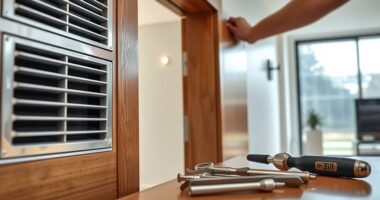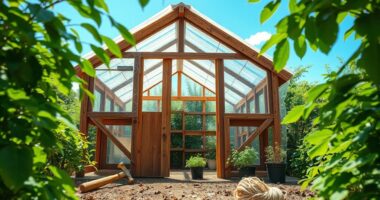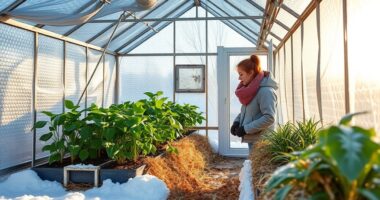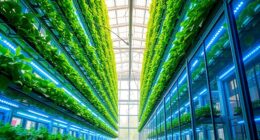To build a basic greenhouse, start by choosing a sunny, well-drained site with good airflow. Gather your materials like framing, panels, and tools. Plan your layout for easy access and ideal light. Prepare the ground by clearing debris and creating a level base. Assemble the frame securely, then attach weatherproof covering and seal gaps. Finally, install ventilation, heating, and watering systems. Continue once you’re ready to learn more detailed steps to guarantee your greenhouse’s success.
Key Takeaways
- Select a sunny, flat site with good airflow and prepare the foundation by clearing debris and testing soil.
- Gather all materials, tools, and safety gear; plan your greenhouse layout for maximum light and accessibility.
- Assemble the frame securely with supports and braces, ensuring stability and proper alignment.
- Attach weatherproof covering materials tightly, sealing edges and gaps to ensure durability and insulation.
- Install environmental controls like ventilation, heating, and watering systems to maintain optimal growing conditions.
Choosing the Ideal Location for Your Greenhouse
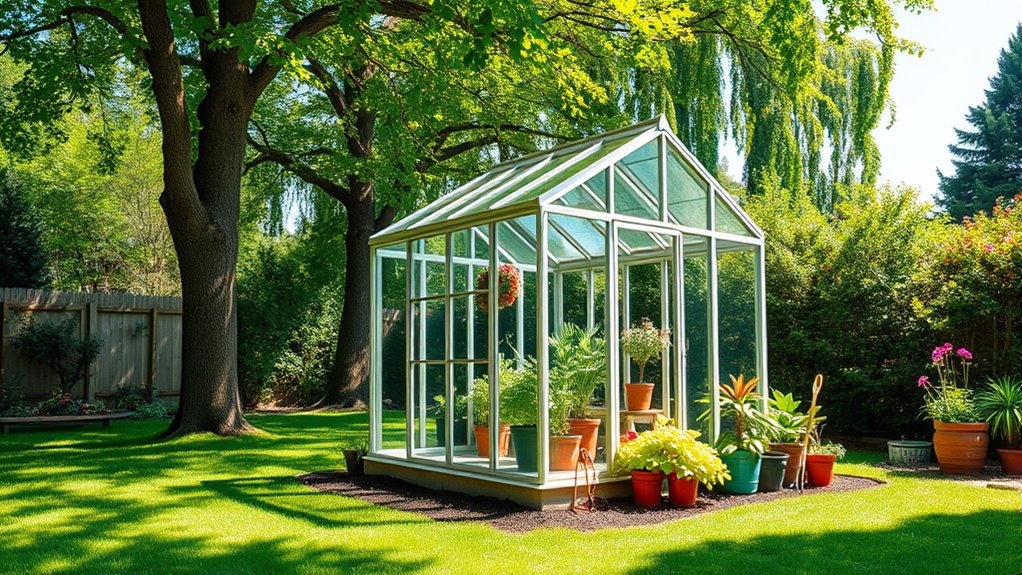
Selecting the right location is crucial for your greenhouse’s success. You want a spot with ample sunlight exposure, ideally facing south, so your plants receive consistent light throughout the day. This boosts growth and helps regulate temperature naturally.
Choose a sunny, south-facing spot for steady light and natural temperature regulation.
Equally important is choosing a location that minimizes pest problems—avoid areas near tall trees or dense shrubbery where pests can hide and invade easily.
Good airflow is essential to prevent mold and mildew, so pick a site that isn’t overly shaded or enclosed.
Consider the slope of the land; a flat or gently sloping site ensures proper drainage and easier maintenance.
Gathering Materials and Tools Needed

Before you start building, it’s essential to gather all the necessary materials and tools to guarantee a smooth construction process. Begin with a tools checklist that includes a hammer, screwdrivers, a saw, a level, and measuring tape. Make sure you have safety gear like gloves and goggles.
For materials, identify reliable material sources such as hardware stores, specialty suppliers, or online retailers. You’ll need transparent panels or plastic sheeting for the walls, framing materials like wood or metal, and fasteners such as screws or nails.
Double-check your list to ensure you don’t miss anything. Having everything on hand before you begin saves time and prevents interruptions during the build, making the process more efficient and enjoyable.
Designing Your Greenhouse Layout and Size
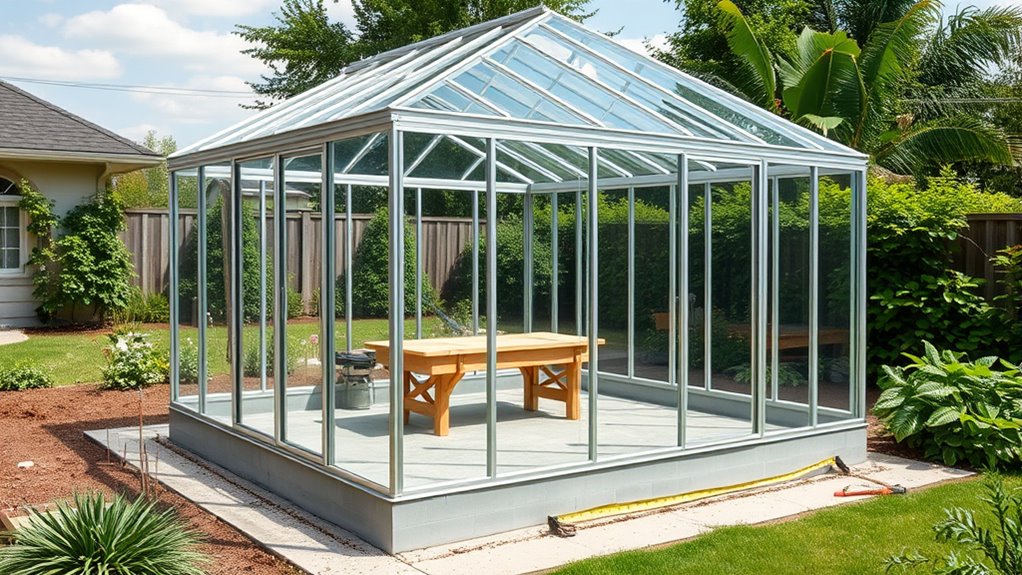
With your materials and tools ready, it’s time to plan the layout and size of your greenhouse. Consider how much space you’ll need for your plants and how you’ll access different areas. Think about ventilation options—placing vents or windows for airflow will help maintain ideal conditions and prevent overheating. The layout should maximize sunlight exposure, so position taller plants or structures accordingly. Don’t forget to enhance greenhouse aesthetics; choosing a design that blends well with your yard makes the space more inviting. Keep in mind the overall footprint to ensure stability and ease of access. Additionally, understanding Free Floating greenhouse construction basics can guide you in making structural choices that promote durability and safety. Incorporating innovative planters into your design can also improve plant growth and visual appeal. Sketching a simple floor plan helps visualize the arrangement, allowing you to make adjustments before construction begins. Proper planning now saves time and effort later, especially when size restrictions are a concern for your location. Being aware of robotics expansion in logistics can inspire the integration of automated systems to assist with watering or monitoring your greenhouse environment.
Preparing the Foundation and Base
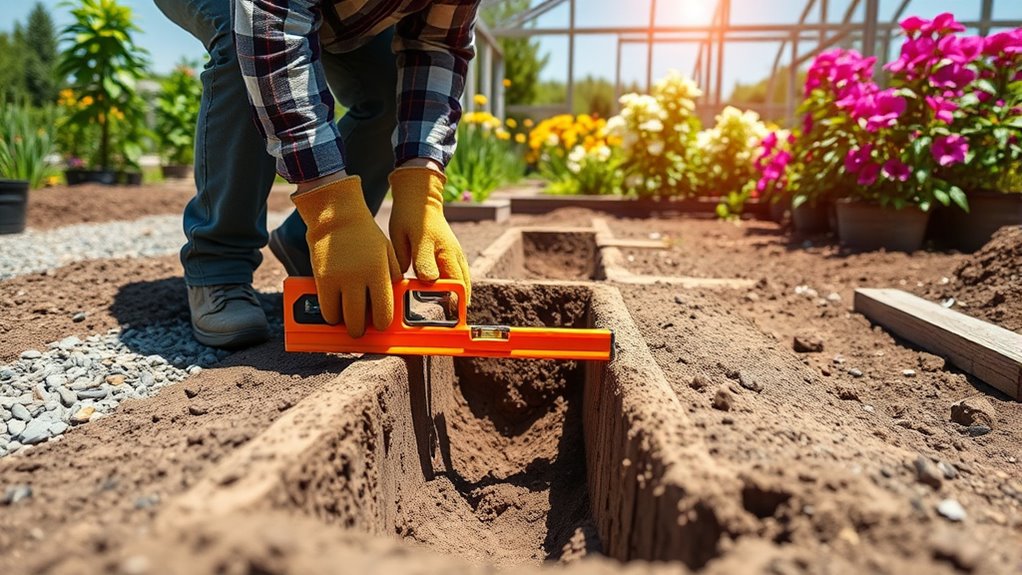
Start by choosing a suitable site that’s flat, well-drained, and receives plenty of sunlight. Once you’ve selected the spot, lay a solid foundation and make certain the surface is level to keep your greenhouse stable. Proper preparation now will make assembly easier and improve the structure’s durability. Additionally, consider soil quality to ensure a healthy environment for your plants and to support the stability of the greenhouse foundation. Understanding permits and inspections in your area can also help prevent future legal issues and ensure your greenhouse complies with local regulations. Consulting best practices for construction can further assist in creating a secure and efficient setup for your greenhouse. Being aware of digital literacy programs can also be beneficial if you or your team need to improve your familiarity with modern tools and technology used in greenhouse management. Incorporating vacuum cleaner performance metrics principles, such as proper filtration and maintenance, can also be advantageous if you plan to keep your workspace clean and free of dust.
Selecting Suitable Site
Choosing the right site is crucial for a successful greenhouse, as it directly affects sunlight, drainage, and overall stability. You should evaluate the area for ideal sun exposure, ideally six hours or more daily.
Conduct soil testing to determine nutrient levels and drainage capacity, ensuring the soil can support plant growth. Check for existing pest issues and implement pest control measures beforehand.
Look for a flat or gently sloped location to prevent water pooling and soil erosion. Avoid areas near trees or structures that could block sunlight or cause shading.
Additionally, consider future expansion and accessibility. Remember, a well-chosen site simplifies construction, reduces maintenance, and promotes healthy plant growth. Proper site selection sets the foundation for a thriving greenhouse.
Laying the Foundation
Before assembling your greenhouse, you need to prepare a solid and level foundation. Start by clearing the area of debris, weeds, and loose soil. Proper soil preparation is essential to guarantee stability and drainage; consider adding gravel or compacted soil to improve support. Check for pest activity, and treat the soil if needed to prevent future infestations. Remove any roots or rocks that could cause unevenness or damage to the structure. If planting directly into the ground, consider laying a weed barrier. For added stability, you can install concrete blocks, treated wood, or a gravel bed as a base. Incorporating energy-efficient foundations can also enhance sustainability and reduce long-term environmental impact. Additionally, selecting appropriate materials for your foundation can further improve the greenhouse’s durability and insulation properties. Utilizing modern construction techniques can streamline the foundation process and ensure long-lasting support. A well-prepared foundation will provide a sturdy, pest-free platform, making your greenhouse durable and functional for years to come.
Ensuring Level Surface
Once you’ve cleared and prepared the area, the next step is guaranteeing the foundation is perfectly level. Proper soil leveling is essential for foundation stability, preventing shifting or uneven stress on your greenhouse.
Use a long, straight board and a spirit level to check the surface, making adjustments as needed. If the ground is uneven, add or remove soil to create a flat, firm base.
Compact the soil thoroughly to prevent future settling. A level surface ensures your structure remains sturdy and secure over time.
Assembling the Frame Structure

Assembling the frame structure is a crucial step that sets the foundation for your greenhouse. Start by connecting vertical supports with horizontal beams using metal connectors. Secure each joint firmly to guarantee stability. Frame reinforcement is essential—double-check connections and add braces where needed. Using proper tools, tighten all bolts and screws to prevent wobbling. Keep your structure level and square as you proceed. Remember, a sturdy frame resists weather and supports covering materials later on. To visualize the importance, consider this table:
| Solid Foundation | Frame Reinforcement |
|---|---|
| Prevents wobbling | Ensures durability |
| Supports weight | Enhances stability |
Additionally, applying performance cookies can help monitor the stability of your construction process to identify any issues early. Proper structural support is vital for long-term success and resilience of your greenhouse. Incorporating early detection of issues can prevent costly repairs down the line. Ensuring the robustness of the frame is essential to withstand environmental stresses and extend the lifespan of your greenhouse. Furthermore, using high-quality materials can significantly improve the overall durability and longevity of your structure.
Installing Covering Materials and Weatherproofing
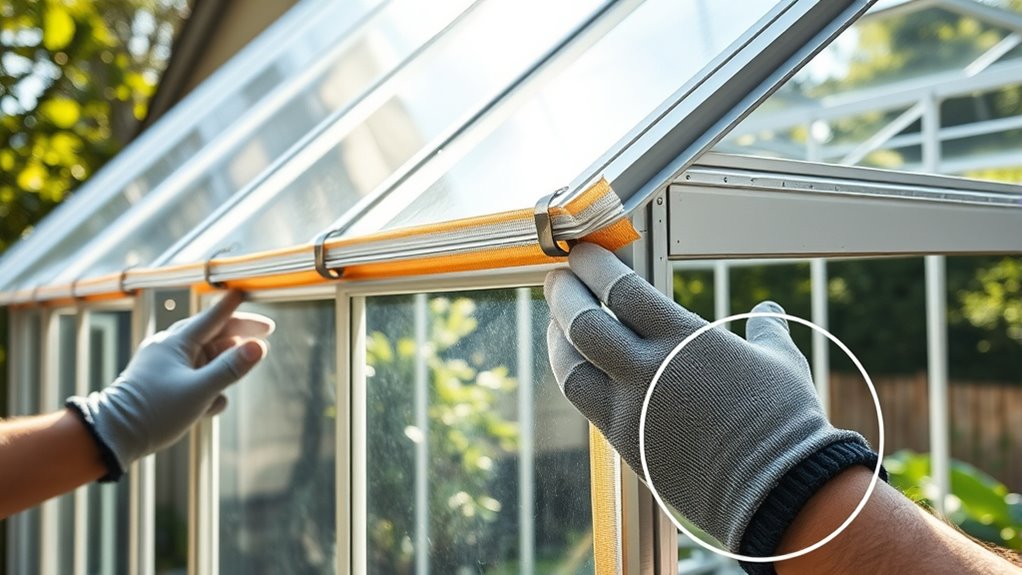
Choosing durable cover materials is key to protecting your greenhouse from the elements. You’ll need to properly attach each layer to guarantee it stays secure and effective. A well-installed covering can also help maintain a consistent internal temperature, especially if you consider weatherproofing measures. Proper sealing of gaps and edges is essential to prevent drafts and air leaks, which can compromise temperature regulation and energy efficiency inside the greenhouse.
Select Durable Cover Materials
Have you considered which cover materials will best withstand weather conditions and last over time? Choosing durable materials ensures your greenhouse remains protected and efficient.
Opt for materials like durable polycarbonate, which offers strength and impact resistance, or UV resistant plastic that prevents sun damage and fading. These materials provide excellent insulation and longevity, reducing the need for frequent replacements.
Keep in mind that the right cover material can influence temperature regulation and light transmission, critical for plant growth. To make the best choice, consider your climate, budget, and desired light levels.
Properly Attach Covering Layers
Once you’ve selected the right cover materials, the next step is to properly attach them to guarantee your greenhouse remains weatherproof and secure. Different cover material types, such as polycarbonate panels, polyethylene film, or acrylic sheets, require specific attachment methods. Use appropriate fasteners like screws, clips, or tensioning systems to ensure a tight fit.
Apply weatherproofing techniques, such as sealing edges with weatherstripping or using sealant tapes, to prevent drafts and leaks. Make sure the cover is taut and evenly secured to avoid sagging or gaps that could compromise insulation.
Proper attachment not only enhances durability but also maximizes light transmission and temperature control inside your greenhouse. Take your time to secure each layer firmly for a weather-resistant, long-lasting structure.
Seal Gaps and Edges
To guarantee your greenhouse stays weatherproof, it’s essential to seal all gaps and edges where the covering material meets framing or other surfaces. Proper weatherproofing seals prevent drafts, moisture intrusion, and heat loss.
Use high-quality edge insulation to ensure a tight fit around doors, vents, and panels. Apply weatherproofing seals along seams and joints to block gaps that could compromise the environment inside.
For best results, double-check all edges after installation to confirm a secure seal. Remember, well-sealed edges improve energy efficiency and protect your plants from unexpected weather changes.
- Ensure continuous edge insulation around all openings
- Use weatherproofing seals at seams for airtight protection
- Regularly inspect and re-seal gaps to maintain weatherproofing
Setting Up Ventilation, Heating, and Watering Systems
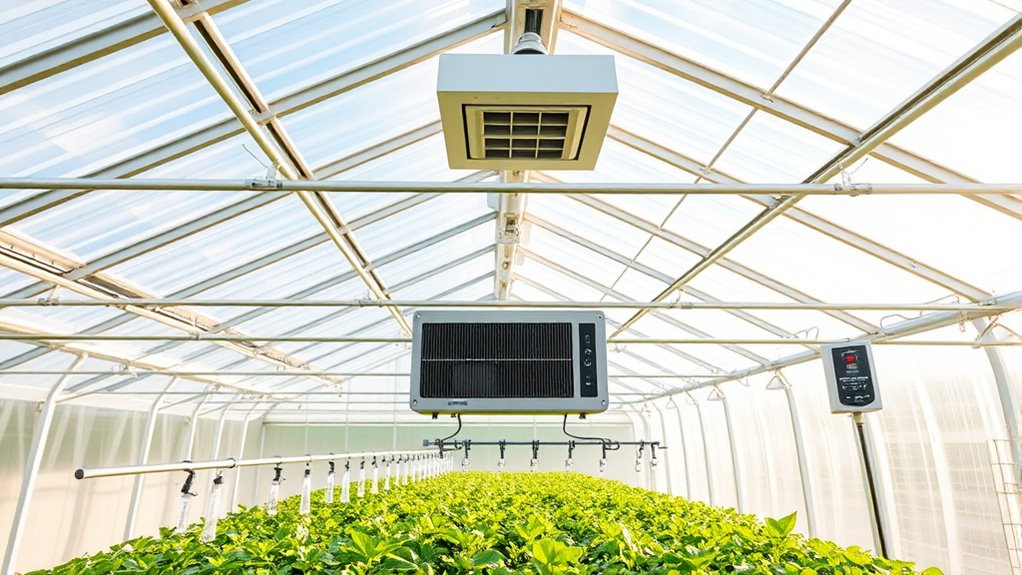
Setting up effective ventilation, heating, and watering systems is essential to creating a healthy environment inside your greenhouse. Proper ventilation strategies help regulate temperature and humidity, preventing mold and pests. Install exhaust fans or vents that open automatically when temperatures rise.
For heating, consider electric or propane heaters, ensuring even heat distribution without creating cold spots. Establish watering schedules that match your plants’ needs, avoiding over- or under-watering. Use drip irrigation or soaker hoses for consistent moisture and save water.
Regularly monitor sensors to adjust ventilation and heating as conditions change. These systems work together to maintain stable temperatures and humidity levels, promoting healthy plant growth.
Frequently Asked Questions
How Much Will Building a Greenhouse Cost Overall?
When estimating the cost of building a greenhouse, you should consider factors like size, materials, and location.
Your cost estimation will vary based on your choices, but a basic DIY greenhouse can start around $500 to $2,000.
For better budget planning, include expenses for foundation, framing, glazing, and ventilation.
Keep in mind, investing in quality materials may raise initial costs but offers better durability and long-term value.
What Permits or Regulations Are Required Locally?
Think of your greenhouse as a seed of growth, needing the right permissions to flourish. You’ll need to navigate local zoning laws and building codes, which act like guardians protecting community harmony.
Check with your city or county to see if permits are required for construction or structure size. This guarantees your greenhouse stays compliant, allowing your gardening dreams to bloom without legal worries.
How Long Does It Take to Complete the Greenhouse?
Building your greenhouse usually takes around one to three weeks, depending on your construction timeline and material sourcing.
If you’ve already gathered all materials, you can expect quicker progress. Delays in sourcing supplies or permitting issues might extend this time.
You’ll need to allocate time for site preparation, assembly, and finishing touches, but with efficient planning, you could have your greenhouse ready in just a week or two.
Can I Build a Greenhouse in Winter?
You can build a greenhouse in winter, but you need to plan carefully. Winter construction requires choosing the right materials, like durable framing, and ensuring proper greenhouse insulation to retain heat.
You’ll want to work during milder days, prepare your foundation in advance, and consider adding supplemental heating.
With the right precautions, your winter project can be successful, allowing you to enjoy fresh plants year-round despite the cold outside.
What Are the Best Plants to Grow in a Beginner Greenhouse?
For a beginner greenhouse, you should focus on easy-to-grow, beginner-friendly crops. Think about plant selection options like lettuce, radishes, herbs, and tomatoes, which thrive in controlled environments.
These crops grow quickly and require minimal maintenance, making them perfect for your first greenhouse experience. By choosing these beginner-friendly plants, you’ll gain confidence and enjoy fresh produce while learning the basics of greenhouse gardening.
Conclusion
Building a greenhouse might seem simple, but it’s a game-changer for your gardening dreams. By following these steps, you’re not just creating a shelter—you’re crafting a mini paradise that could outshine the most lush botanical gardens. Stay patient and precise, and soon you’ll watch your plants thrive like never before. Remember, this isn’t just a project; it’s the foundation of a green oasis that could transform your entire outdoor space into a living masterpiece.


